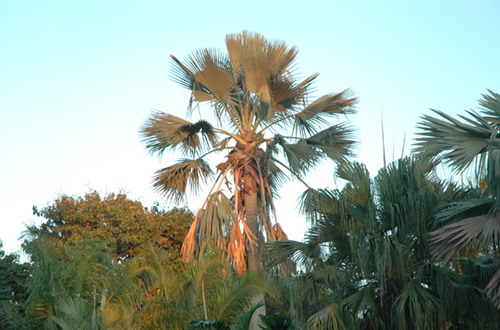
Borassus
aethiopum at sunset
December
29, 2010
Angela
Cano, botanical scholar from Geneva,
studies palm collections at Montgomery
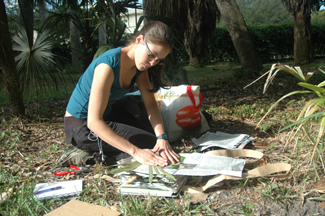 Angela Cano, a first year master’s student from
The University of Geneva, working with the Conservatory and
Botanical Garden of Geneva, is being hosted at Montgomery to
collect DNA and voucher specimens for research on her thesis. She
is working on a monographic revision for Trithrinax and its
place in the phylogeny of the palm tribe Cryosophileae. Angela Cano, a first year master’s student from
The University of Geneva, working with the Conservatory and
Botanical Garden of Geneva, is being hosted at Montgomery to
collect DNA and voucher specimens for research on her thesis. She
is working on a monographic revision for Trithrinax and its
place in the phylogeny of the palm tribe Cryosophileae.
Recent work here in Miami by FIU and
FTBG illuminated the
phylogeny of West Indian palms, which included many Cryosophileae.
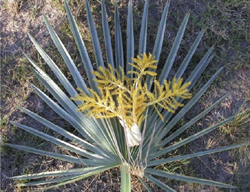 Phylogeny and
placement of Trithrinax is yet to be examined. Ms.
Cano’s research will use modern techniques to clarify relationships
between species in Trithrinax, a genus that has been
unstudied for 80 years. Phylogeny and
placement of Trithrinax is yet to be examined. Ms.
Cano’s research will use modern techniques to clarify relationships
between species in Trithrinax, a genus that has been
unstudied for 80 years.
Trithrinax are well armored
palms, with long sharp spines on their trunks and spiny leaf
tips. They are used to thatch roofs and have a showy white fleshy
fruit that is beautiful, though not good for consumption. It is a
cold tolerant palm that is native to southern South America.
“Fred Stauffer recommended that I come
to Montgomery Botanical Center because of its large collection of
palms. The collection is great and the location is ideal, with
only a short walk between Montgomery and Fairchild,” said Angela Cano.
November
2010
Fall/Winter
2010 Montgomery
Botanical News is Now Online!
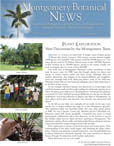 This new
issue has articles organized around the theme of exceptional
plants: new and interesting plants collected, plants no other garden
grows, and newly designated Champion Trees. This new
issue has articles organized around the theme of exceptional
plants: new and interesting plants collected, plants no other garden
grows, and newly designated Champion Trees.
Montgomery Botanical Center publishes two
newsletters a year to keep
our supporters and collaborators up to date and informed. To read
more about how Montgomery Botanical Center meets our mission of
"Advancing Research, Conservation, and Education through Scientific
Plant Collections" please see our newsletters
online. Make sure to take a look at the photo on the back from
the Montgomery Archive with Colonel Montgomery and Nell admiring their Kigelia
pinnata.
November
6, 2010
Chris
Tyson Plant Conservation Building Dedicated
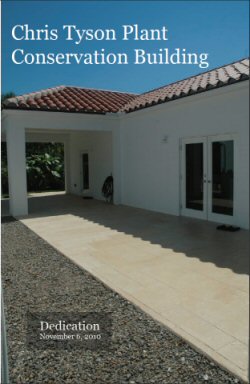 The Chris
Tyson Plant Conservation Building was dedicated today at Montgomery. This is a very important advancement for MBC
-- providing the greatly needed capacity to house our plant
conservation and botanical research work. The Chris
Tyson Plant Conservation Building was dedicated today at Montgomery. This is a very important advancement for MBC
-- providing the greatly needed capacity to house our plant
conservation and botanical research work.
Mrs. Tyson's generous gift enabled
Montgomery to construct a new, larger facility for the seedbank
program, and also provide much needed workspace for botanical
research, for visiting colleagues and the MBC team.
Christiane Tyson, a longtime volunteer at
MBC, and supporter of botany, horticulture, and gardens, saw the need
for this facility at MBC. Christiane and Christopher Tyson worked
closely with MBC, its architect, and landscape architect, to design a
building that meets Montgomery's increasing work needs, and also
integrates with the existing architecture and garden design.
Over 100 guests gathered for the
dedication, and included many of the Tyson Family, who travelled great
distances to attend. MBC's friends, colleagues, supporters,
board, and staff were represented, as well as many of Miami's botanical
instutions: The
Kampong, Pinecrest
Gardens, The Gifford
Arboretum, Fairchild
Tropical Botanic Garden, and botanists from Florida International
University, and the University
of Miami.
A selection of speakers offered remarks
on the occasion, highlighting how horticulture and botany will see
greater success through Mrs. Tyson's generous gift. MBC President
Charles P. Sacher highlighted all of MBC's ongoing work in botany that
will be based in the new building. John DeMott shared the history --
and future growth -- of the seedbank program. Dr. Carol Horvitz spoke
of how this moves collaboration among our botanical community forward
for the sake of plant science. 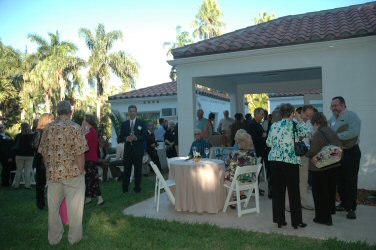
Chris, a dedicated plant enthusiast, was
presented with a seedling to commemorate the occasion. Dr. Patrick
Griffith, MBC Executive Director stated:
"If you know Chris, you know that she
loves to give and receive plants. This, of course, is what marks a true
plant person – unfettered exchange of these living treasures. Chris and
I have shared a number of interesting plants over the years.
Today, I would like to present Chris with
a very special plant, one that exemplifies why her gift means so much.
The plant here is Microcycas calocoma,
a critically endangered cycad. Our seedbank program has helped this
plant a great deal. This is a finicky, difficult to propagate plant,
and a glacially slow growing one. There are less than 600 plants in the
wild. Our work at MBC, through Judy Kay, our seedbank coordinator, has
produced and distributed over 6,000 seeds!
That is over 10 times as many plants as
in the wild. Making this rare, expensive, difficult and coveted plant
widely available is our goal. This reduces poaching, and ensures the
species will not go extinct. This is just one example of why we grow
plants and the great work we can do through our seedbank.
Please accept this living treasure on behalf of the MBC team. Chris, with your gift, we look forward
to many more successes like this one. "
Christiane Tyson then related her
perspective, and shared her vision for helping gardens and botanists.
Chris highlighted her values, how she realized she could help move
botany forward, and shared her desire to see good projects continue.
Please enjoy the Dedication
Program, see a selection of photographs
from the reception, and join MBC in thanking the Tysons for their
deeply generous gift and for their dedication to gardens.

November 5, 2010
MBC, Belize
Botanic Gardens, and Gemini Gardens study cycads in Belize
 Belize is home to a rich cycad flora, with five native
species in an area the size of New Hampshire. Two of these
species, Zamia decumbens and Zamia meermanii, both endemic to
Belize, were described by MBC Cycad Biologist Michael Calonje based on extensive
fieldwork in 2008 assisted by MBC Executive Director Dr. Patrick
Griffith, and Jan Meerman. Belize is home to a rich cycad flora, with five native
species in an area the size of New Hampshire. Two of these
species, Zamia decumbens and Zamia meermanii, both endemic to
Belize, were described by MBC Cycad Biologist Michael Calonje based on extensive
fieldwork in 2008 assisted by MBC Executive Director Dr. Patrick
Griffith, and Jan Meerman.
Michael Calonje and Collections Manager Dr. Chad Husby returned to
Belize from October 29- November 5 to continue studies on Z. decumbens and Z. meermanii. Michael and
Chad worked with colleagues from Belize Botanic Gardens:
Rudy Aguilar, Freddy Salvador and Sinead McCormick. Paul Craft of
Gemini Gardens also helped to organize portions of the trip.
In remote sinkholes in the Maya
Mountains, two key populations of Z. decumbens were sampled for
assessment of their genetic diversity. The plants were also
measured and labeled for long-term population monitoring. The
team collected seeds of Z. decumbens
and Z. meermanii for
conservation horticulture at Belize Botanic Gardens and
Montgomery. In addition, seeds of several rainforest palms were
collected, including Calyptrogyne
ghiesbreghtiana, Reinhardtia
gracilis, and Chamaedorea
geonomiformis.
The team also continued collaboration on Zamia dispersal research with MBC
colleague Jan Meerman of Green Hills Botanical
Collections, the Belizean ecologist for whom Zamia meermanii is named.
Chad states: “The success of this fieldwork resulted from the
effective collaboration of many colleagues. Despite the short
time-frame, all the goals of the trip and more were accomplished,
resulting in gathering of key scientific data and very important
conservation collections.”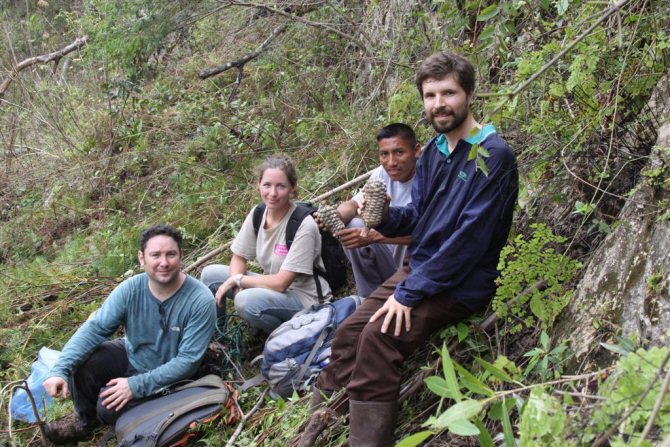
October 30, 2010
Boy Scouts restore Studio, build
furniture, and mulch colonnade
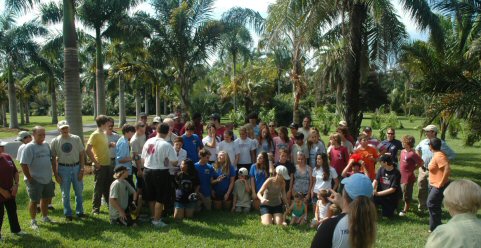 A very large group of dedicated volunteers -- Boy Scouts, their
families, and friends -- came together today at
Montgomery for the Eagle Scout project of Emerson King, Boy
Scouts of America Troop 457. A very large group of dedicated volunteers -- Boy Scouts, their
families, and friends -- came together today at
Montgomery for the Eagle Scout project of Emerson King, Boy
Scouts of America Troop 457.
The group built and
donated two picnic tables, three bookcases, and two benches, and worked
quickly and fastidiously to mulch each palm and cycad from the main
entrance to Nell's House, comprising Colonel Montgomery's Royal Palm
Colonnade.
The centerpiece of the
project was the restoration of the 1934 Studio, which has served as the
MBC
Seedbank for over a decade. Emerson, his father, and a select group
of Scouts worked to restore the plaster walls, build and finish the
trim on the interior of the doorway, and prepare and paint the entire
workspace.
 "During 13 years of service as the MBC Seedbank, this
modest room handled a very large volume of horticulture work," states
Patrick Griffith, MBC Executive Director. "Years of pollen, seeds,
tools, soil, and all of the important work in here made this room ready
for a restoration. This workspace has really been made new again!" "During 13 years of service as the MBC Seedbank, this
modest room handled a very large volume of horticulture work," states
Patrick Griffith, MBC Executive Director. "Years of pollen, seeds,
tools, soil, and all of the important work in here made this room ready
for a restoration. This workspace has really been made new again!"
The MBC Seedbank
propagates, collects, and distributes seed from MBC's living plant
collection. This program works through an agreement with the Florida Nursery Growers and
Landscape Association.
Tracy Magellan, MBC
Outreach Manager, states, "Everything Emerson planned turned out great.
The Royal Palm Colonnade was well-manicured, and up to our high
horticultural standard. The Studio transformation was amazing. Troop
457 has really helped us out this year, and we look forward to more
Eagle Scout projects in the future."
October 22, 2010
Joint Fieldwork by Montgomery, Fairchild, and the
National Herbarium of Trinidad and Tobago
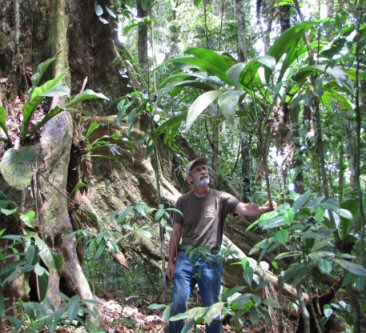 Montgomery Botanical Center, Fairchild Tropical Botanic
Garden, and the National
Herbarium of Trinidad and Tobago participated in a joint fieldwork
project during October 2010, in Trinidad. Melissa Abdo (project
leader) and Juan Rivera of FTBG, and Yasmin
Baksh-Comeau of the University of the West Indies worked with Dr. Larry
Noblick, MBC Palm Biologist. Montgomery Botanical Center, Fairchild Tropical Botanic
Garden, and the National
Herbarium of Trinidad and Tobago participated in a joint fieldwork
project during October 2010, in Trinidad. Melissa Abdo (project
leader) and Juan Rivera of FTBG, and Yasmin
Baksh-Comeau of the University of the West Indies worked with Dr. Larry
Noblick, MBC Palm Biologist.
Larry reports that the trip resulted in a successful extension of fieldwork
in 2007. Further information, specimens, and living collections
of palms were developed and shared.
Astrocaryum aculeatum,
Attalea maripa,
and Bactris campestris are
three very interesting species collected. In the photo
here, Larry stands on Morne Bleu with Prestoea
pubigera, a species that occurs only in Trinidad and on the
Paria Peninsula in Venezuela. Basic biogeographic work by herbaria,
coupled with living garden collections, create a unique and important
set of resources for research and conservation.
A series of articles by Melissa
on the FTBG website (1,
2,
3)
detail the fieldwork. In addition, the team worked on herbarium
projects centered around the University of the West Indies in St.
Augustine. Larry states, "Melissa and Juan are good people to collect
with, they both have very pleasant personalities and are great in the
field. And it was great to work with Yasmin and Winston Johnson, who
are both true experts on the Trinidadian Flora."
October 17, 2010
Boy Scouts work hard for sustainability at Montgomery
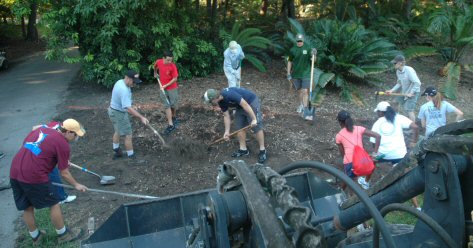 A
group of Boy Scouts, their families, and their friends -- 40 people in
all -- put in an long day of hard work at MBC this Sunday.
Jonathan Hirst of Boy Scout Troop
840, Pinecrest, Florida, organized the project as part of
his Eagle Scout award. A
group of Boy Scouts, their families, and their friends -- 40 people in
all -- put in an long day of hard work at MBC this Sunday.
Jonathan Hirst of Boy Scout Troop
840, Pinecrest, Florida, organized the project as part of
his Eagle Scout award.
The MBC Cycad Walk, implemented during the 1990s, used
a variety of soils and top dressings, as raised beds organized by
geography. This practice functions well for many cycads, but improved
practice in recent years groups cycads by habitat type and uses native
soils at grade. Mulch
surfaces, whether raised or at grade, and whether rock, compost, or
wood chips, always require more labor and treatments than natural turf.
Jonathan's
project converted selected horticultural features at MBC into
sustainable ecoturf surfaces, which improve plant
health and reduce environmental impact, and are also more
resource-efficient. Functionally,
the project required removal of a tree, and lots and lots of heavy
digging. Sand, heavy soil, clay, mulch, and granite gravel were dug out
by
hand and separated for recycling in the garden. A total of 50 cubic
yards of
material were excavated by the project. The areas were then raked flat
and seeded. The resulting new line of the cycad walk follows design
principles from MBC's landscape architect, and works to soften and
improve sharp curves and steep slopes. 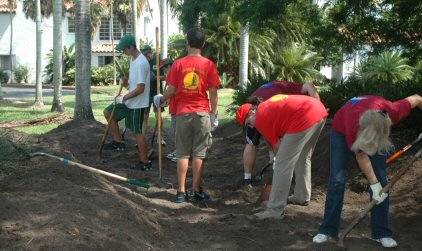
"Jonathan's project certainly followed excellent
landscape design, and greatly improved things from a sustainability
viewpoint," stated Patrick Griffith, MBC Executive Director, " but I
was most impressed by all of the 'heavy lifting' that these Scouts put
in. These are hard working young men, and thier efforts here will help
MBC for years to come. This is true dedication to sustainability."
Tracy Magellan, MBC Outreach Manager, concurred, "its
wonderful to see the way this group works together. I am certainly very
grateful for Jonathan's hard work, and we all enjoyed Troop 840's great
team spirit."
October 15, 2010
MBC shares best practices with the
public garden world
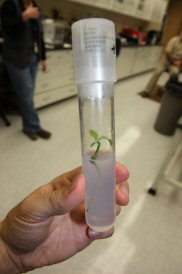 Montgomery Botanical Center’s achievements in ex situ
conservation were featured at the “Collections
Management Best Practices” symposium organized by the American
Public Gardens Association. The symposium took place at the
Denver Botanic Gardens in Colorado from October 13-15 and offered many
opportunities for more than 100 public garden curators to share
expertise and different approaches to managing living collections. Montgomery Botanical Center’s achievements in ex situ
conservation were featured at the “Collections
Management Best Practices” symposium organized by the American
Public Gardens Association. The symposium took place at the
Denver Botanic Gardens in Colorado from October 13-15 and offered many
opportunities for more than 100 public garden curators to share
expertise and different approaches to managing living collections.
MBC Collections Manager Dr. Chad Husby presented a talk entitled
“Managing Living Plant Collections for Conservation” that emphasized
MBC’s pursuit of fieldwork, research, horticulture, and mutually
beneficial collaborations to achieve successful ex situ conservation
outcomes.
Chad was asked to participate as an expert in managing
living plants for conservation purposes. Chad states, "The symposium
was very well organized by APGA and the Denver Botanic Gardens,
offering a unique opportunity to share insights into the best ways to
manage living collections"
The conference also featured a tour of the USDA’s National Center for
Genetic Resources Preservation which gave the participants an
opportunity to explore state of the art techniques for preserving seeds
and other types of plant material.
September 25, 2010
The South Florida Palm Society plants
over 120 palms at MBC
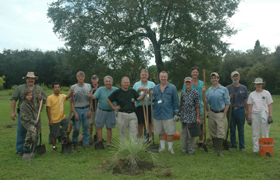 The South Florida Palm
Society (SFPS) volunteered to assist Montgomery in planting over 120
palms. The trees planted were primarily Sabal palmetto,
Butia paraguayensis, and Butia yatay. The South Florida Palm
Society (SFPS) volunteered to assist Montgomery in planting over 120
palms. The trees planted were primarily Sabal palmetto,
Butia paraguayensis, and Butia yatay.
These palms, part of
MBC’s living collection, came from fieldwork in the Bahamas, Paraguay
and Argentina, part of MBC’s collections development work.
Dr. Larry Noblick states,
“I greatly appreciate the generosity and work ethic of the palm
enthusiasts from the SFPS. They saved us a lot of time and helped us
achieve our goal of getting all of our palms in the ground by the end
of September.”
September 2, 2010
Dr. Fred Stauffer Offers Lecture, and Studies Palm Flowers at
MBC
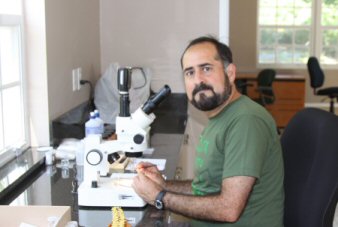 Dr. Fred
Stauffer, of the Conservatoire
et Jardin Botaniques de la Ville de Genève in Switzerland,
studied the MBC palm collections this week. Fred is an expert in the
anatomy and morphology of palm flowers, and Fred and his students have
recently published new research on palm flowers that made use of MBC
material. Dr. Fred
Stauffer, of the Conservatoire
et Jardin Botaniques de la Ville de Genève in Switzerland,
studied the MBC palm collections this week. Fred is an expert in the
anatomy and morphology of palm flowers, and Fred and his students have
recently published new research on palm flowers that made use of MBC
material.
While being hosted at
Montgomery, Fred offered a lecture on the morphology and anatomy of
palm flowers, placing this information in the context of recent
evolutionary studies. During his lecture, Fred stressed two important
points. Firstly, Dr. Stauffer emphasized the importance of mentoring
the next generation of palm scientists - education is vital for botany.
Fred also praised MBC and other gardens for working to 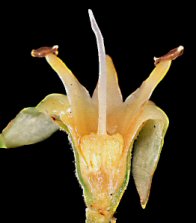 keep plant
collections for the research community. "It is great to have so
many palm species available for study here, flowering at the same
time," stated Dr. Stauffer. keep plant
collections for the research community. "It is great to have so
many palm species available for study here, flowering at the same
time," stated Dr. Stauffer.
Due to the timing of his
visit, Fred also had the distinction of being the first visiting
researcher at Montgomery to work in the Chris Tyson Plant Conservation
Building. This facility was recently completed, and will be dedicated
in November. Fred was enthusiastic about the workspace, stating: "This
building is a wonderful resource for a visting botanist."
The Geneva Conservatory
and Botanic Garden houses two exceptional collections, each very
important for botanists. First, the herbarium
(CJB) houses 6 million plant specimens, and is particularly rich in
type specimens. The library at
Geneva is one of the premier botanical libraries in the world. The
library and the herbarium are the legacy of De Candolle, the early
Swiss botanist who was very influential in plant systematics and the
study of evolution.
August 14, 2010
The University of Miami School of
Law’s HOPE Students Help at MBC
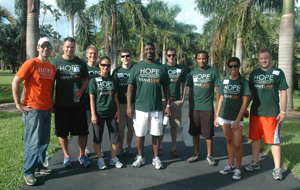 Ten student
volunteers from the University of
Miami' s Helping Others
Through Pro Bono Efforts (HOPE) came to Montgomery Botanical Center
and helped with a large-scale mulch to ecoturf conversion. Their work
helped MBC to achieve its mission of exemplifying excellent botanic
garden design. Having ten extra hands to help with the project
saved MBC days of work. Ten student
volunteers from the University of
Miami' s Helping Others
Through Pro Bono Efforts (HOPE) came to Montgomery Botanical Center
and helped with a large-scale mulch to ecoturf conversion. Their work
helped MBC to achieve its mission of exemplifying excellent botanic
garden design. Having ten extra hands to help with the project
saved MBC days of work.
Montgomery Botanical Center has
a growing living collection with many extremely rare species. MBC
is very thankful to all the students who helped out. The
University of Miami School of Law’s HOPE Public Interest Resource
Center sent hundreds of law students to approximately 25 sites across
Miami-Dade County through the
Annual Hope Day of Service. MBC is glad to have been one of the 25
participating institutions.
Executive Director
Patrick Griffith states, “These students gave a tremendous effort and
really helped out with the garden. Only the most intrepid will
volunteer outdoors in a Miami August weekend!”
August 6, 2010
Montgomery Botanical Graduate Fellowship at Florida
International University
 MBC and FIU have just
signed an agreement creating the Montgomery Botanical Graduate
Fellowship at FIU. MBC and FIU have just
signed an agreement creating the Montgomery Botanical Graduate
Fellowship at FIU.
“The Board of Directors
at MBC is very excited about this agreement. This marks a significant
commitment to education and research in botany by both our garden and
the University,” states Patrick Griffith, MBC Executive Director.
The Montgomery Botanical
Graduate Fellowship will fund a Research Assistant at FIU, who will
perform guided research in palms, cycads, and botanic garden
conservation. The first Montgomery Botanical Graduate Fellow is Michael
Calonje, MBC Cycad Biologist, who will continue his research on Zamia
at MBC and FIU, while working towards a Ph.D. in Biology. Michael
states, “This opportunity will greatly enhance my research by providing
training in new skills, allowing access to FIU’s robust infrastructure,
and allowing me to interact with many of the great minds at FIU. It is
a great privilege to be a recipient of this Fellowship and I am very
grateful.” 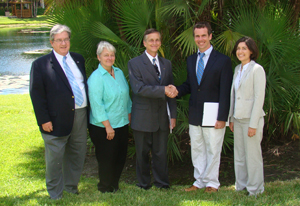
Patrick, along with
Outreach Manager Tracy Magellan from MBC, designed this program with
FIU Dean Ken Furton, FIU Senior Associate Dean of Sciences Suzanna
Rose, and FIU Assistant Dean of Development Robert Callahan. The
program is structured to collaboratively advance botany at both
institutions, by pooling resources and taking advantage of
complementary strengths.
“This is a perfect
arrangement – everyone contributes, and everyone benefits,” states
Patrick. “Our unsurpassed living collections of palms and cycads, and
our work in plant exploration, when coupled with the excellent
education and research tradition at FIU, will create solid outcomes in
botanical research for both.”
Dean Furton concurs,
stating “Formal and informal relationships between FIU and MBC can be
traced back over twenty years, highlighting a record of collaboration
amongst scientists. This new and energetic relationship with MBC
capitalizes on FIU’s recognized strength in tropical botany and
conservation biology.”
August 1, 2010
Martin-Rami Fund Sponsors Tree Planting at MBC
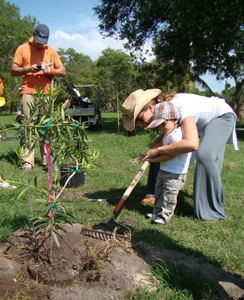 Montgomery Botanical
Center is pleased to announce the initiation of the Martin-Rami Fund,
which sponsors tree planting at MBC. The Martin-Rami Fund is the vision
of Mrs. Beatriz Eugenia Cardona de Tessy - Genita, who shares the same
commitment to living trees as the MBC team. Montgomery Botanical
Center is pleased to announce the initiation of the Martin-Rami Fund,
which sponsors tree planting at MBC. The Martin-Rami Fund is the vision
of Mrs. Beatriz Eugenia Cardona de Tessy - Genita, who shares the same
commitment to living trees as the MBC team.
Everyone agrees that one
of the best things you can do is to establish a tree. Trees provide
shade, clean the air, provide habitat for birds, and beautify the
landscape. Planting a tree is the first step, but caring for that tree,
nurturing and monitoring it as it develops, and ensuring its health are
equally essential. Trees planted at MBC are carefully tended and thrive
in the botanic garden setting. 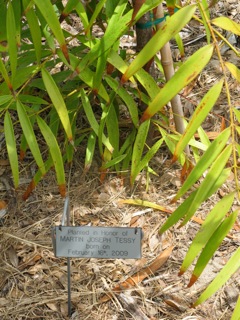 Beyond the
important benefits that all trees provide, trees at MBC also function
as important research and education resources. Many trees at MBC are
the only representatives of their species in the United States. Caring
for rare and imperiled tree species in the garden helps ensure that
these living treasures do no go extinct. Beyond the
important benefits that all trees provide, trees at MBC also function
as important research and education resources. Many trees at MBC are
the only representatives of their species in the United States. Caring
for rare and imperiled tree species in the garden helps ensure that
these living treasures do no go extinct.
Thus, the Martin-Rami
Fund, by sponsoring tree planting at MBC, enables four fundamental
conservation functions; improving our environment; providing an
educational resource for students; contributing to scientific research;
and ensuring against extinction.
Genita writes, “The
Martin-Rami Fund sponsors living trees in honor of Martin Joseph Tessy
Cardona, and his guardian angel Rami Chirara. Their loving awareness
inspires this gift to the earth, as everyone, regardless of their
situation, may contribute to the planting of a tree in a simple and
sustainable way.”
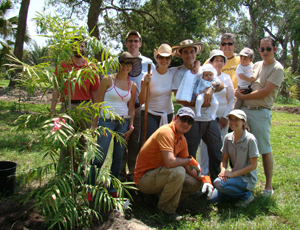 “When I spoke
with Genita and found out that she was interested in planting trees at
MBC I was thrilled. Every year we have over 1,000 trees to plant and
every bit of help is greatly appreciated,” stated Tracy Magellan, MBC
Outreach Manager. “When I spoke
with Genita and found out that she was interested in planting trees at
MBC I was thrilled. Every year we have over 1,000 trees to plant and
every bit of help is greatly appreciated,” stated Tracy Magellan, MBC
Outreach Manager.
Dr. Patrick Griffith, MBC
Executive Director, states: “I’m inspired by the vision and
colleagueship of Mrs. Cardona. After discussing her ideas with Tracy,
Genita brought her family and friends to MBC to plant some important
trees last June. Now, Genita has made a greater commitment, and is
involving a wider group. Planting trees is at the heart of what we do
at MBC. I’m truly grateful for Genita and the Martin-Rami Fund, which
help enable that important work.”
July 7, 2010
The
Coral Gables Museum City Trekker Summer Camp
Learns about Gardens at Montgomery
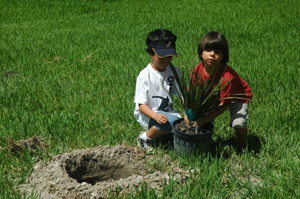 Caroline Parker,
Director of Programs for the Coral Gables Museum, brought 21 students
to Montgomery Botanical Center to learn about botanic gardens through a
palm planting workshop. Caroline Parker,
Director of Programs for the Coral Gables Museum, brought 21 students
to Montgomery Botanical Center to learn about botanic gardens through a
palm planting workshop.
The children enthusiastically
enjoyed planting an important group of Sabal Palms in the Lowland
Palmetum. 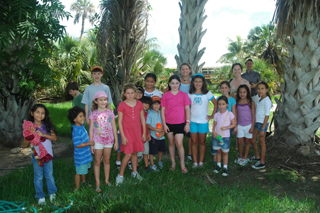
Caroline’s idea to dedicate one
week to learning the importance of botanic gardens demonstrates
excellent planning in the CGM summer camp program. Landscape design,
sustainability, horticulture, conservation, and botany are all
important topics that are part of growing a plant collection.
"The children did an excellent
job planting and helped us immensely," said Laurie Danielson. "They
made a great contribution to our garden."
June 24, 2010
Montgomery
Botanical's Work Featured at National and International Meetings
A focus on living botanical collections
remains at the heart of the botanical garden community. As evidence:
Montgomery Botanical Center's work was selected for presentation at the
two major garden conferences this summer. Dr. Chad Husby and Dr.
Patrick Griffith presented a total of six presentations at these
gatherings.
The American Public Gardens
Association conference was hosted by Atlanta Botanical Garden
in early June. Chad presented his recent research on weed risk
assessment for botanical garden collections, and Patrick contributed a
talk on how MBC rethought its work in mapping living collections.
Additionally, Patrick was asked to give a summary of how MBC developed
hurricane response protocols for the plant collection. Along with
Tracy Magellan, Chad and Patrick also participated in the NAPCC forum
as part of the conference. Longtime MBC colleague Ron Determann
shared his extensive conifer and cycad collections with the MBC team.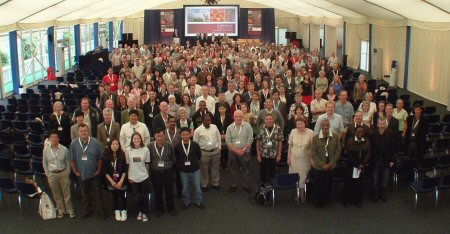
A few days after the APGA conference, Botanic Gardens Conservation International
convened the 4th Global Botanic
Gardens Congress at the National
Botanic Gardens of Ireland, in Glasnevin.
Chad was again encouraged to discuss the
weed risk assessment work in a session on invasive plant issues and
gardens, while Patrick presented MBC's work with bringing together
conservation genetics and economics. Chad took advantage of the
worldwide gathering to exchange Equisetum
cuttings with other dedicated plantsmen from France,
Scotland, and Finland.
At the request of the organizing committee, Dr. Andrew Vovides convened a special session
dedicated to cycad collections, which brought together speakers
from the Mexican National Cycad Collection, The New York Botanical
Garden, Shenzhen Fairy Lake Botanical Garden, Lowveld National Botanical Garden, and MBC. Patrick
contributed an overview of MBC cycad work,
with recent examples in conservation and research.
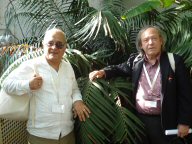 The
famous conservatories at Glasnevin are home to many important cycad
collections, including the type collection of Ceratozamia fuscoviridis, which
was studied by Dr. Stevenson, Dr. Vovides, and Dr. Osborne for a recent
publication. This individual plant has been in
cultivation at Glasnevin since the nineteenth century! Attendees of the cycad session were
treated to a special viewing of this collection by Dr. Matthew Jebb. The
famous conservatories at Glasnevin are home to many important cycad
collections, including the type collection of Ceratozamia fuscoviridis, which
was studied by Dr. Stevenson, Dr. Vovides, and Dr. Osborne for a recent
publication. This individual plant has been in
cultivation at Glasnevin since the nineteenth century! Attendees of the cycad session were
treated to a special viewing of this collection by Dr. Matthew Jebb.
"These gatherings are an excellent
opportunity, both to share MBC's work, and to make and strengthen
connections with our friends and colleagues around the world. The MBC
team is very grateful for the gracious hospitality and hard work of
the host gardens in Atlanta and Dublin, and the great organizations
that make these events happen," stated Patrick.
June 21-27, 2010
National
Pollinator Week at Montgomery
A great deal of specialized work goes
into pollinating plants at MBC.
Loss of natural habitat and unscrupulous
poaching puts a big pressure on cycads. Cycad seeds produced at MBC are
shared with other botanical gardens, educational institutions, and
scientific researchers. Collectors have a chance to purchase
the rare seeds legally, and as the supply expands poaching could
lessen.
So, for National Pollinator Week, MBC
would like to highlight the work of Judy Kay, MBC Seedbank Coordinator.
Here, Judy shares her field notes on managing the cycad collections for
seed production, and some observations on palms and other collections:
“For the last ten years, the cycads have
been quite consistently cyclic. Encephalartos male cones shed
pollen August–May. The females are receptive August–December, and
disperse seeds January–March.
Cold temperatures only affect Encephalartos
ferox females. They will close up immediately if receptive, and if
already pollinated they may abort the seeds. I always leave an
unpollinated control cone to see if any new pollinators have been
introduced. None have appeared so far. 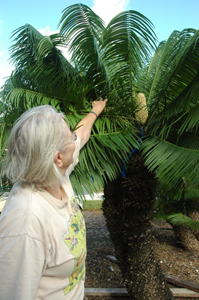
Cycas has had many open
pollinated seeds from 2000–2010. The male cones shed pollen April–June.
The females are receptive April–June and the seeds are harvested
August–November. This year the long cold spell had a very
dramatic effect on the female Cycas panzhihuaensis. This rare
Cycas is a cold hardy cycad, which grows in high
altitudes in China. Since 2002, we have had many male cones but
only two females. Now we have over 13 female cones, including one plant
exhibiting five female cones.
Dioon spinulosum and D.
mejiae had a few open pollinated viable seeds each year from
2000-2010. They produce pollen, receptive cones and seeds at various
times during the year. Since it takes two-three years for the seeds to
mature, plants will often have several hand pollinated cones from
different years. The seeds are usually already sprouted when the cone
begins to disarticulate.
Microcycas calocoma has the
most efficient schedule. Pollen and receptive cones both exist
August–September. Seeds are harvested the following June–July. No
open pollinations recorded.
Ceratozamia have pollen
February–May and receptive cones May–July. Seeds are harvested the next
January–May with no open pollinations.
Zamia, except for the Zamia
inermis, are usually pollinated by a local pollinator. (See
MBC Newsletter Spring 2007 for pollinator exclusion experiments).
Successful palm pollinations include Nypa fruiticans, Bismarckia
nobilis, Pseudophoenix vinifera, and Allagoptera
arenaria. Fruit and flowering trees pollinated include Brownea
capitella and Butea monosperma. MBC collaborated with
Fairchild Tropical Botanical Garden and The Kampong to cross pollinate Couroupita
guianensis, sharing fruits and seeds.”
During Judy’s time at MBC, she has
generously shared information, records, pollen, and demonstrated her
methods to visiting experts from many botanic gardens. Judy states,
“I’m always happy to answer any questions or give demonstrations of
pollination techniques–The more rare seeds we can produce, the less
rare they will be!”
June 18, 2010
Montgomery
Botanical Research Fellow Dr. John Dowe
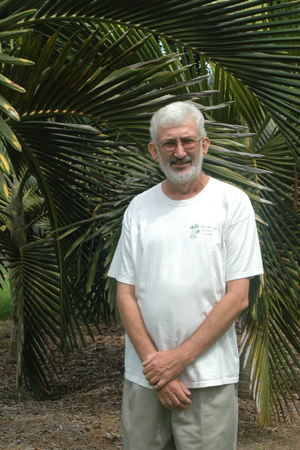 Dr. John Leslie Dowe is
a Research Botanist based at James Cook University, Townsville,
Australia and a Research Fellow with Montgomery Botanical Center. Dr.
Dowe has worked on the systematics, ecology and taxonomy of Australia
palms for the last 20 years. Dr. John Leslie Dowe is
a Research Botanist based at James Cook University, Townsville,
Australia and a Research Fellow with Montgomery Botanical Center. Dr.
Dowe has worked on the systematics, ecology and taxonomy of Australia
palms for the last 20 years.
John has provided revisions of the
Australian palm genera of Archontophoenix (1994), Caryota
(1994), Linospadix (1997), Licuala (2005), and
Livistona (2009). His work in the south-west Pacific and New
Guinea has included a taxonomic account of the palms of Vanuatu (1996),
a revision of Calyptrocalyx (2001) and research into the rare
and threatened species Carpoxylon macrospermum (1989, 1997).
In February of 2010 Dr. Dowe published the definitive reference work on
Australian palms:
‘Australian Palms: Biogeography, Ecology and Systematics’,
published by CSIRO Publishing, Australia.
Dr. Dowe presented two talks on Livistona,
one at Fairchild Tropical
Botanic Garden for the South Florida Palm
Society and one in Orlando for the Central Florida Palm and
Cycad Society. Dr. Dowe also presented two lectures on the
public palm collections of North Queensland, Australia, one in Largo,
FL and one here at Montgomery Botanical Center. The talk presented at
MBC titled, “A Palm Road-Trip: Visiting the Public Palm Collections of
North Queensland, Australia” focused on the many interesting palms
found at each of six public gardens.
While in Miami, Dr. John Dowe and Dr.
Larry Noblick used the scanning electron microscope at the University
of Miami to look at the surface textures of different Australian palm
pollen grains that were collected in Australia and in the United States
at Fairchild Tropical Botanic Garden and Montgomery Botanical
Center. Dr. Dowe has been using Montgomery Botanical Center’s
living collection since 1996. Actively supporting research is an
integral component of the mission here at MBC.
The Montgomery Botanical Research Fellows
Program is generously supported by the Kelly Foundation, in order to
advance research on the MBC living collection and share this research
with the botanical community.
June 8,
2010
AmeriCorps
helps MBC
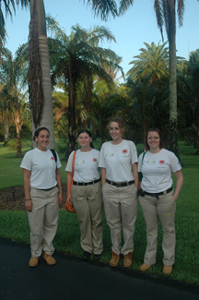 City Year, a branch of
AmeriCorp, visted MBC to help us with a large-scale weeding
project. The event was organized as part of City Year Miami’s 96
Hours of Power, a program designed to have members volunteer around the
clock for a 4 day period. City Year, a branch of
AmeriCorp, visted MBC to help us with a large-scale weeding
project. The event was organized as part of City Year Miami’s 96
Hours of Power, a program designed to have members volunteer around the
clock for a 4 day period.
City Year members serve as full-time
tutors, mentors and role models in high-poverty schools. There are
1,550 members serving nationally who volunteer 2.5 million hours
annually.
MBC was very happy to work with City
Year. It is great to see youth embrace volunteering. Hand
weeding is a safe and effective way to remove large weeds that have
established themselves in the collection. Weeds compete with our
collection for water and nutrients. Removing weeds can cut down
fertilizer and water usage and beautify the collection.
Thank you City Year for helping MBC meet
our mission of exemplifying excellent botanical garden design and
helping us maintain the beauty of our extraordinary collections.
June 7,
2010
Proper Palm
Planting Techniques Taught at MBC
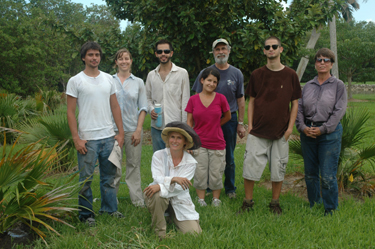 Miami Dade College’s
Palm Diversity & Maintenance class visited MBC to assist with the
summer planting. The course teaches identification and good maintenance
practices for the major species of palms commonly found in South
Florida. Miami Dade College’s
Palm Diversity & Maintenance class visited MBC to assist with the
summer planting. The course teaches identification and good maintenance
practices for the major species of palms commonly found in South
Florida.
MBC has a history of using good
maintenance practices and valuing exemplary botanic design.
During the 2010 summer planting season, a total of 1,150 plants will go
in the ground, 600 of which will be palms.
MBC’s wild-collected, population-based,
tropical plant collections are extraordinary in their scientific,
conservation, and educational value. “Montgomery Botanical Center
takes great pride in educating students on proper palm planting
techniques. As an adjunct professor at Miami Dade College, I know
that hands on activities solidify ideas and techniques discussed in
class. Exposing students to the application of methods taught in
class allows them to better absorb the information,” said Tracy
Magellan.
May 12, 2010
Pollination Biologist Dr. Irene Terry Studies MBC
Cycad Collections
Dr. Irene Terry,
from the University of Utah, is an expert on the pollination biology of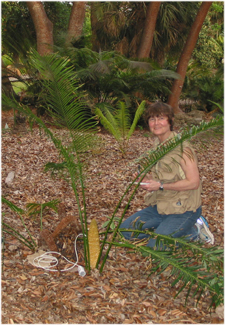 cycads. Her recent
work looks closely at the mutual relationship between cycads and their
pollinators. cycads. Her recent
work looks closely at the mutual relationship between cycads and their
pollinators.
Through innovative
methods, Dr. Terry has advanced our understanding of how cycads attract
pollinators, and has brought to light aspects of cycads cone biology.
Cones of the genus Cycas produce abundant volatile compounds,
which give them sometimes very distinctive fragrances. Some can be
described as suggesting licorice or pineapple odors. Additionally, the
cones heat up significantly during the reproductive phase, which
facilitates attracting the pollinators.
Quoting from Dr. Terry’s
recent research: “the reproductive organs of some plants self-heat,
release scent, and attract pollinators. The relations among these
processes are not well understood, especially in the more ancient,
nonflowering gymnosperm lineages.”
Over the last week, Dr.
Terry has been gathering data on temperature and chemistry of Cycas
collections here at MBC, as part of her work with Dr. Tom Marler at the
University of Guam. Working with Claudia Calonje, MBC Collections
Specialist, Dr. Terry reviewed the phenology data to time her research
visit to coincide with pollen shedding of many Cycas cones.
This use of MBC living
collections for pollination biology continues an important field of
study here. For many years, cycads were assumed to be wind pollinated.
In recent decades, the pollination of cycads by weevils and beetles was
thoroughly documented on plants growing on the MBC grounds.
Dr. Terry states, “it is a
great advantage to have a living collection of so many cycad species at
one location to compare cone traits that are key to their reproductive
biology.”
May 6, 2010
Current Cycad Conservation and Research in Mexico:
Dr. Andrew Vovides and Dr. Miguel Angel Perez-Farrera
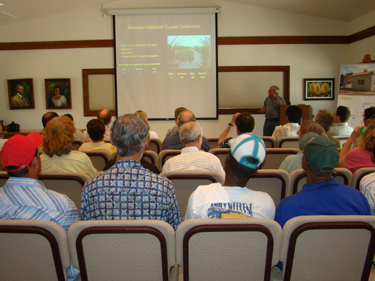 Two cycad experts from
Mexico were recently hosted by Montgomery Botanical Center. Dr. Andrew
Vovides, Montgomery Botanical Research Fellow (1989) from Instituto de Ecología,
A.C., Xalapa, Veracruz, Mexico, and Dr. Miguel Angel Perez-Farrera
from the Universidad de Ciencias
y Artes de Chiapas, Mexico reviewed the cycad collections, planned
collaborative research, and presented their current work. Two cycad experts from
Mexico were recently hosted by Montgomery Botanical Center. Dr. Andrew
Vovides, Montgomery Botanical Research Fellow (1989) from Instituto de Ecología,
A.C., Xalapa, Veracruz, Mexico, and Dr. Miguel Angel Perez-Farrera
from the Universidad de Ciencias
y Artes de Chiapas, Mexico reviewed the cycad collections, planned
collaborative research, and presented their current work.
Dr. Vovides presented a lecture titled, "New Cycad Research in
Mexico:Advances in Taxonomy, Biogeography, and Molecular
Barcoding." Dr. Perez-Farrera presented a lecture on the Ceratozamia
robusta complex: taxonomy and systematics. The lectures were heard
by visitors from many research institutions. Biologists from Florida
International University, the Florida Division of Plant Industry,
Gemini Gardens, the USDA, Fairchild Tropical Botanic Garden, and The
University of Utah attended the reception and lecture.
A leading cycad researcher in Mexico, Dr. Andrew Vovides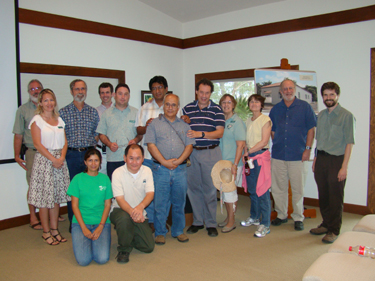 established the
Jardin
Botanico Francisco Javier Clavijero and the Mexican National Cycad
Collection, one of the world's most important cycad conservation
collections. Dr. Vovides and Dr. Perez-Farrera are longtime
collaborators with MBC, going back over 20 years. Most recently, Dr.
Perez-Farrera worked with MBC's Michael Calonje on 2008
fieldwork in Belize. established the
Jardin
Botanico Francisco Javier Clavijero and the Mexican National Cycad
Collection, one of the world's most important cycad conservation
collections. Dr. Vovides and Dr. Perez-Farrera are longtime
collaborators with MBC, going back over 20 years. Most recently, Dr.
Perez-Farrera worked with MBC's Michael Calonje on 2008
fieldwork in Belize.
The important work by Dr. Vovides and Dr. Perez-Farrera is an excellent
example of the merging of research, conservation, and education, and
mirrors our mission here at MBC. MBC thanks the Kelly Foundation for
supporting the Montgomery Botanical Research Fellows Program, which
brings cycad and palm experts to MBC to advance joint research.
April
29, 2010
Montgomery
Botanical hosts a Green Discussion:
Mayor Slesnick and Environmental
Law Students
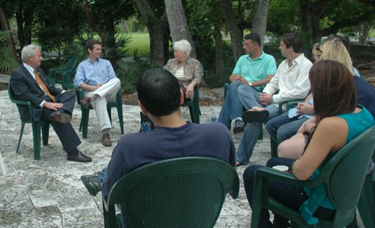 Patricia
Siemen, Director of the Center for Earth Jurisprudence at St. Thomas University, visited MBC with
six law students. Their visit coincided with the last meeting for a
course on Earth Jurisprudence. The students remarked that seeing the
work of MBC firsthand "brought the lessons from the seminar home," by
exemplifying conservation practice. Patricia
Siemen, Director of the Center for Earth Jurisprudence at St. Thomas University, visited MBC with
six law students. Their visit coincided with the last meeting for a
course on Earth Jurisprudence. The students remarked that seeing the
work of MBC firsthand "brought the lessons from the seminar home," by
exemplifying conservation practice.
Coral Gables Mayor
Don Slesnick came to MBC to discuss how the City of Coral Gables
has greened their community. Mayor Slesnick cited MBC as a leading
example of a green organization in Coral Gables, noting that "the
greenest thing you can do is plant a tree." The Mayor's conversation
with the students also highlighted the value of historical
preservation; "One way we can decrease our carbon footprint is by
restoring old buildings with new green technologies. Tearing down an
old building to build a new one uses far more resources than restoring
the old building."
The Mayor's visit to MBC comes on the one year anniversary of "Montgomery
Botanical Center Day in Coral Gables" established by proclamation
as April 29, 2009, and also on the 85th birthday of the City.
April
26, 2010
Montgomery Palm
Biologist, Larry Noblick, Co-Authors New Book on Brazilian Palms
 A
new book on Brazilian Palms has been published. Brazilian Flora
Lorenzi: Arecaceae (Palms) details 300 species, varieties, and
natural
hybrids of palms native to Brazil. The work, authored by Harri Lorenzi,
Larry Noblick, Frances Kahn, and Evandro Ferreira, contains extensive
diagnostic keys, and presents each palm with detailed photographs,
descriptions, and distribution maps. The work also contains
detailed summary descriptions of each genus. A
new book on Brazilian Palms has been published. Brazilian Flora
Lorenzi: Arecaceae (Palms) details 300 species, varieties, and
natural
hybrids of palms native to Brazil. The work, authored by Harri Lorenzi,
Larry Noblick, Frances Kahn, and Evandro Ferreira, contains extensive
diagnostic keys, and presents each palm with detailed photographs,
descriptions, and distribution maps. The work also contains
detailed summary descriptions of each genus.
Published by Instituto
Plantarum de Estudos da Flora, the work is
available in both Portuguese and English. The book is
organized to
be of great use for a diversity of readers. Quoting
the book, "it is intended
fundamentally for individuals interested in the art of gardening and
landscaping, either as an amateur or professional, to nurserymen who
provide seedlings of ornamental plants, to researchers of this group of
plants, to professors and students of biological sciences in general,
as well as palm fanciers, collectors, and those who love nature and
enjoy viewing plants in their natural habitat."
This recent volume is
the result of over 15 years of study of the Brazilian palm flora,
investigating palms in the field and in the living collections at the
Instituto Plantarum, Montgomery Botanical Center, and other
gardens. Dr. Larry Noblick, MBC Palm Biologist, led the work on Butia, Lytocaryum, and Syagrus, continuing his work on
these palm groups
related to the coconut palm. Of note is the great
diversity of Syagrus
found in Brazil, especially the diminutive savanna and grassland
species. Dr. Noblick’s work with these plant groups has brought more of
these
interesting diminutive palms to light in recent months.
April
21, 2010
New Research
on Cycad Conservation Horticulture at MBC
Montgomery Botanical Center is dedicated
to conserving living collections of cycads. With new living material
coming through the nursery, the MBC team is
often challenged to cultivate plants poorly known to
horticulture.
A
new paper in the journal HortScience explores the optimum growing medium for new Zamia collections. This study examined the
health of seedlings of Z. cunaria,
Z. fairchildiana,
and Z. aff. portoricensis which were brought
to MBC by fieldwork in Panama
and Jamaica
in 2008. These plants grow in a variety of habitats, and in this study,
the plants 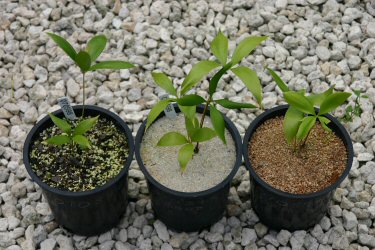 were grown in a variety of media, including crushed
clay, silica sand, and a more traditional mix of organic and inorganic
components. The plants varied in caudex diameter and leaf number
relative to the media, in accordance with their provenance. were grown in a variety of media, including crushed
clay, silica sand, and a more traditional mix of organic and inorganic
components. The plants varied in caudex diameter and leaf number
relative to the media, in accordance with their provenance.
The study was designed by Dr. Chad Husby,
working with Claudia Calonje and Michael
Calonje. Chad states: "Determining the proper growing conditions for
rare plants requires flexibility and a willingness to experiment.
Since fostering good root growth is essential to plant health, finding
the best substrates for our collections is crucial to advancing our
conservation mission."
Quoting the paper, "Optimizing substrates
for cycad propagation is a critical step in ex situ conservation
efforts. Predictability of optimal substrate and watering regime
relative to native habitat can help increase efficient use of limited
resources for these horticulturally unique living fossils." The MBC
team is currently utilizing the findings to advance the cycad program,
and further studies are underway.
April 8, 2010
Gifford Arboretum Lecture co-sponsored by MBC
Montgomery Botanical Center was honored to co-sponsor
the 22nd
Gifford Arboretum Lecture at the University of Miami. Dr.
John Kress of the National Museum of
Natural History, Smithsonian Institution gave a lecture titled, “DNA
Barcoding in Plants: The Future of Identification, Discovery, and
Conservation of Tropical Biodiversity.” Dr. John Kress’s work
investigates tropical biology, ethnobotany, evolution, and plant
systematics. “DNA barcoding, when developed, will make importing and
exporting plants from country to country easier. There will be
less confusion about what should or should not be transported. I
look forward to seeing this come into fruition in my lifetime,” states
Tracy Magellan.
After the lecture, John Kress signed his latest book, The
Weeping Goldsmith. The book chronicles his experiences
exploring for plants in the isolated country of Myanmar.
“The Gifford Arboretum always brings such
wonderful speakers to our community; it was very inspiring to
hear Dr. Kress speak about the great barcoding work. This novel way to
study and conserve plant diversity will provide all kinds of great
insights into plant biology. The Gifford
Arboretum is a great organization and a unique resource, and MBC is
always happy to co-sponsor The Gifford Lecture,” said Executive
Director Dr. Patrick Griffith.
April
2010
Spring/Summer
2010 Montgomery
Botanical News is Now Online!
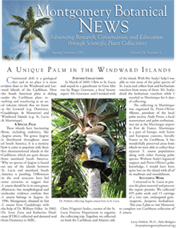 This new
issue has articles on fieldwork in St. Lucia, Martinique, the
Bahamas, Tonga, and the Fiji Islands. There are also articles on
the 50th Anniversary, best management practices, and cold damage at MBC. This new
issue has articles on fieldwork in St. Lucia, Martinique, the
Bahamas, Tonga, and the Fiji Islands. There are also articles on
the 50th Anniversary, best management practices, and cold damage at MBC.
Montgomery Botanical Center publishes two newsletters a year to keep
our supporters and collaborators up to date and informed. To read
more about how Montgomery Botanical Center meets our mission of
"Advancing Research, Conservation, and Education through Scientific
Plant Collections" please see our newsletters
online.
March 27, 2010
Loyd Kelly,
MBC Director Emeritus, Honored at Members Meeting
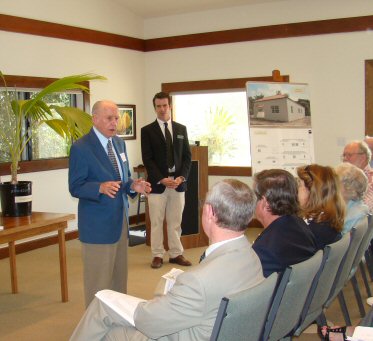 Montgomery Botanical Center's 51st Members Meeting was
held on March 27. The MBC leadership offered updates on the previous
year's work, and plans for the coming year. Montgomery Botanical Center's 51st Members Meeting was
held on March 27. The MBC leadership offered updates on the previous
year's work, and plans for the coming year.
The Members Lecture was given by
Dr. Alan Meerow of Chapman Field, who presented an engaging lecture
titled: Princes, Kings, and Queens:
Palm and Cycad research at USDA and MBC. Alan spoke about the
history of Chapman Field, and the ongoing collaborative work being
performed in connection with MBC staff.
Dr. David Lee of Florida
International University offered positive remarks on the quality of
recent work at MBC, especially regarding cooperative efforts. David
stated his view that "good will does not come out in the statistics,
but is very important, and MBC is creating much good will in Miami's
botanical community"
A highlight of the Members Meeting was
the honoring of Loyd Kelly for his dedicated service. The MBC
Board of Directors unanimously elected to give Loyd the title of
Director Emeritus, to honor his leadership and service on the Board,
especially as President during the important formative years following Nell's death in
1990.
Dr. Patrick Griffith thanked Loyd for his
guidance, leadership, and steadfast support of Montgomery, especially
in the core mission areas of research and education. Patrick then
presented Loyd with three framed drawings on behalf of the MBC team.
These drawings are the original botanical illustrations of Syagrus kellyana, the K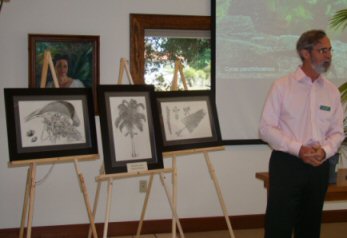 elly Palm. elly Palm.
Dr. Larry Noblick recently named this
palm species after Loyd Kelly. Quoting from the formal description, the new
species "honors Loyd Kelly and his family who have so generously
supported the Montgomery Botanical Center and my research over the years."
Larry spoke of his discovery of the Kelly Palm, and his recollections of being hired by Loyd as MBC's first palm biologist.
Charles P. Sacher, MBC President, then
offered gratitude on behalf of the Board for Loyd's dedicated leadership and service,
noting that Loyd's organizational efforts laid the framework for
Montgomery's current successes.
Loyd then shared his thoughts on MBC and
his vision for leadership, stating, "In leading this organization, I
always believed in a good, rigorous selection process for the people
that we bring in. I believe that we should bring in good people, set
parameters on what we want to see, and then stand back and let the
people do good work. Our successes here come from that philosophy, and
I am glad to see all the good work being continued by our group here at
Montgomery."
March 2010
Dr. Larry
Noblick Describes 15 Interesting New Palm Species
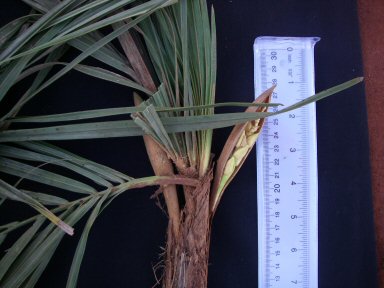 Dr.
Larry Noblick, MBC Palm Biologist, is working on an extensive review of
Syagrus and
closely related
palms. Over the course of extensive
fieldwork, herbarium study, and study of living collections at MBC and
elsewhere, in collaboration with Harri Lorenzi of the Instituto
Plantarum (Brazil), Dr. Noblick determined that reassessment of the
diversity in these palms was needed. Dr.
Larry Noblick, MBC Palm Biologist, is working on an extensive review of
Syagrus and
closely related
palms. Over the course of extensive
fieldwork, herbarium study, and study of living collections at MBC and
elsewhere, in collaboration with Harri Lorenzi of the Instituto
Plantarum (Brazil), Dr. Noblick determined that reassessment of the
diversity in these palms was needed.
The current issue of the journal
Palms (Volume 54)
features two papers by Noblick and Lorenzi, covering the genera Syagrus and Lytocaryum. Fourteen new Syagrus species are described, as
well a single new species of Lytocaryum.
The new Syagrus discoveries include some palms
with conspicuous trunks, as well as a large number of stemless palms
native to the 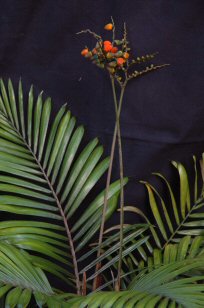 cerrado
and savanna habitats of South America. The authors write: "Several of
the species described below could be used in landscaping and the
smaller ones would be particularly valuable in the landscaping of small
rock gardens. Many of the higher altitude species are probably frost
resistant." cerrado
and savanna habitats of South America. The authors write: "Several of
the species described below could be used in landscaping and the
smaller ones would be particularly valuable in the landscaping of small
rock gardens. Many of the higher altitude species are probably frost
resistant."
These stemless savannah palms
are an area of expertise for Dr. Noblick, who previously described Butia exospadix and Butia marmorii, two palms that
mimic grasses in habit. Syagrus minor,
one of the new species in the recent work, is likely the most
diminutive Syagrus known.
The other new discovery, Lytocaryum
itapebiensis, is a stemless palm of the rainforest understory.
Noblick and Lorenzi have recommended that this palm be classified as
Critically Endangered, as "the only known population is extremely
threatened with only about 20-25 plants left in the wild." The authors
see great potential for ex situ
conservation of this attractive palm.
Palms,
the quarterly journal of the International
Palm Society, features a selection of original papers in the
diversity, uses, and ecology of the palm family, as well as a regular
section devoted to the horticulture of palms.
March 24, 2010
Montgomery
Botanical Center Hosts Students for Environmental Immersion Day
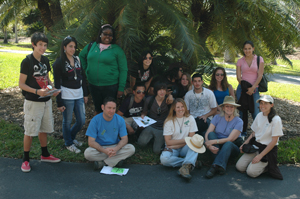 Ten students from
Mr. Phillip Pearcy’s Environmental Science class at G. Holmes Braddock
Senior High School visited Montgomery Botanical Center this week as
part of the Fairchild Challenge Environmental Immersion Day. Ten students from
Mr. Phillip Pearcy’s Environmental Science class at G. Holmes Braddock
Senior High School visited Montgomery Botanical Center this week as
part of the Fairchild Challenge Environmental Immersion Day.
Rotations led by Michael
Calonje, Ericka Witcher, Judy Kay, Tracy Magellan, and Vickie Murphy
taught students about the different technical aspects of working at a
botanic garden.
“Being able to see so many enthusiastic
students from my alma mater brought me great joy. I hope a few
students catch the botany bug,” stated Tracy Magellan.
March 18, 2010
Michael
Calonje and Colleagues
Describe a New Cycad Species from Colombia
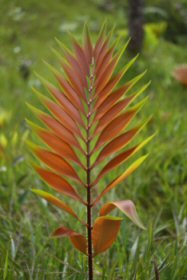 Zamia pyrophylla, a new cycad
species from the lowland tropics of Colombia, was recently
described in the journal Brittonia. The new cycad is visually striking
-- the research team writes: "The specific epithet refers to the
glowing orange and red emergent leaves,
which progressively turn green from the apex to the base, giving them a
fiery appearance." Zamia pyrophylla, a new cycad
species from the lowland tropics of Colombia, was recently
described in the journal Brittonia. The new cycad is visually striking
-- the research team writes: "The specific epithet refers to the
glowing orange and red emergent leaves,
which progressively turn green from the apex to the base, giving them a
fiery appearance."
This
new description resulted from extensive fieldwork led by the
Universidad Tecnológica del Chocó (UTCH) in collaboration
with MBC. Yan Arley Ramos, Director of the CHOCO Herbarium, coordinated
the fieldwork in which several students and alumni of UTCH also
participated.
Intensive study by
the team of five populations of this Zamia
confirmed that this species which was previously
considered a synonym of Zamia
amazonum, was indeed a distinct, undescribed species.
This plant occurs
within a narrow
geographical range in the department of Chocó,
where it is currently threatened by
habitat destruction. Based on census of the plants and field
observations, the project team has recommended that Zamia pyrophylla be listed as
Critically
Endangered, following the
internationally-recognized criteria of the IUCN.
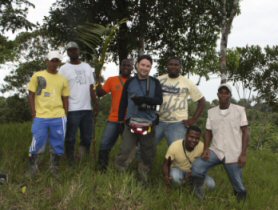 The
new species description is the result of a broad multi-institutional
collaboration, led by Michael Calonje of MBC, and
including Claudia
Calonje (MBC), Yan Arley Ramos (CHOCO), and Dennis Stevenson (The New
York Botanical Garden). Anders Lindstrom also contributed to the
effort. Financial and logistical support from Francois and Angela
Dolmetsch and the Zane B. Carothers Memorial Fund enabled the
fieldwork. The
new species description is the result of a broad multi-institutional
collaboration, led by Michael Calonje of MBC, and
including Claudia
Calonje (MBC), Yan Arley Ramos (CHOCO), and Dennis Stevenson (The New
York Botanical Garden). Anders Lindstrom also contributed to the
effort. Financial and logistical support from Francois and Angela
Dolmetsch and the Zane B. Carothers Memorial Fund enabled the
fieldwork.
Michael
states, “perhaps the most rewarding aspect of this collaborative
research trip for me was the interest awakened among UTCH students in
conducting further research with this species as well as other cycads
native to Chocó. We look forward to future collaborative work
between MBC, UTCH, and the CHOCO herbarium."
March 2010
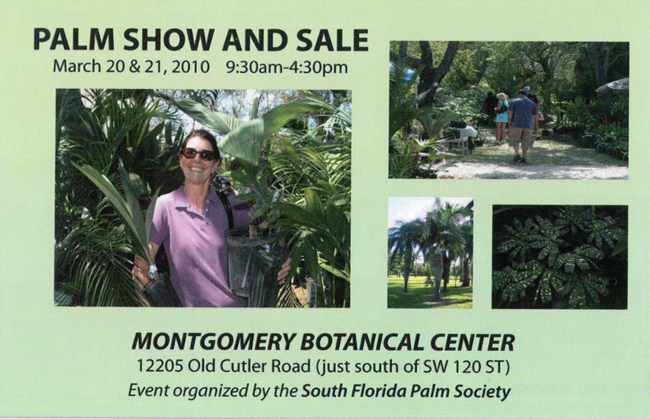
February 26, 2010
How
Effective is Botanic Garden Conservation?
A New Scientific Study of Montgomery's Conservation Method
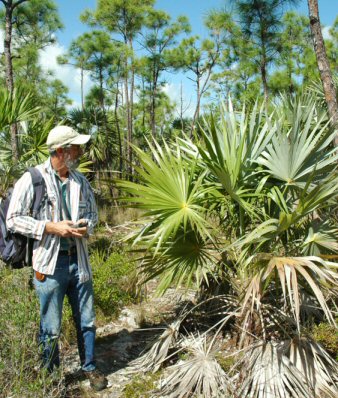 Botanic Gardens
increasingly work to ensure the conservation of endangered plants.
Montgomery Botanical Center is no exception, and MBC plant collections
have been structured to maximize conservation value. But how effective
is this work -- are plants being conserved? Botanic Gardens
increasingly work to ensure the conservation of endangered plants.
Montgomery Botanical Center is no exception, and MBC plant collections
have been structured to maximize conservation value. But how effective
is this work -- are plants being conserved?
A recent paper
in the journal Biological
Conservation evaluates the success of the methods used by
MBC to conserve genetic diversity through living plant collections.
This study used an extensive living collection of a palm species, Leucothrinax morrisii, as a model
system to evaluate botanic garden conservation. The living collection
was the result of a single collecting event from a single population on
Big Pine Key in 1998. Thus, this group of palms provided sufficient
depth to evaluate optimium collection size for a single population.
The
project team revisited the original population, and compared the
genetic diversity of the collection and the population. The resulting
data was used to model the most effective sample size to conserve
genetic diversity.
The
results of the work demonstrate that in this case, maintaining a
collection of at least 15 plants succeeds in conserving at least 80% of
the diversity in the wild population. Increasing the number of plants
in the collection further will increase the conservation value of the
collection, but diminishing returns are seen at higher collection
sizes.
The effect of collecting from separate mother plants was also positive,
but was less significant than simply increasing the number of plants.
This information can be of help for planning conservation work for
palms and other plant groups.
Funding
for this study was awarded by the International
Palm Society. The study, led by Patrick Griffith of MBC, was
performed in collaboration with researchers at Florida International
University and Fairchild Tropical Botanic Garden -- Sandra
Namoff, Javier
Francisco-Ortega, and Carl Lewis -- in addition to MBC's Larry Noblick
and Chad Husby.
February 12, 2010
Montgomery
Botanical Hosts Kampong Physicians' Course
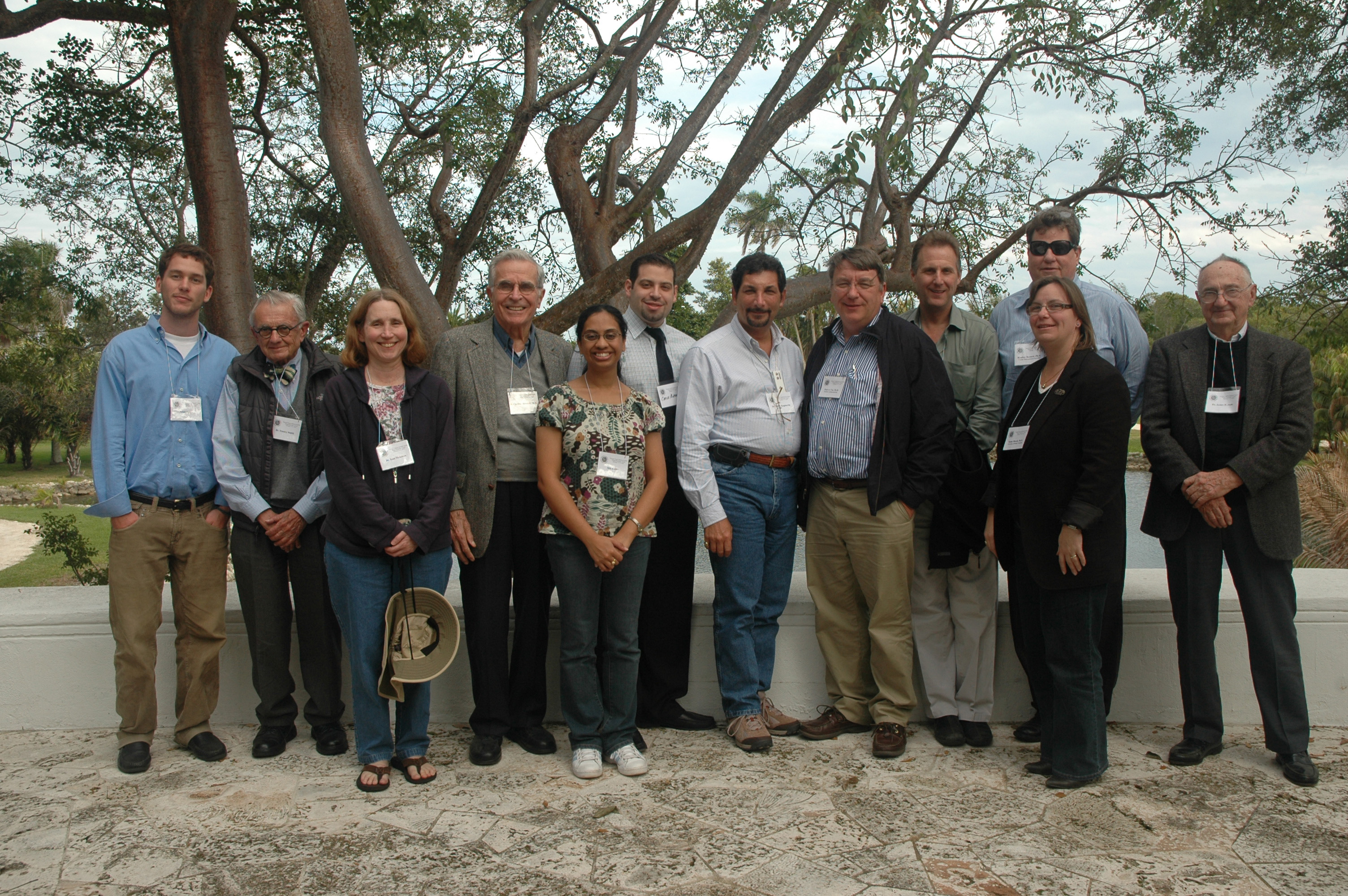 As part of its work
in botanical education, The Kampong recently gave a course for
physicians. Montgomery Botanical Center hosted the physicians and
instructors for an afternoon of seminars, review of the living plant
collections, and a brief introduction to the history and work of MBC. As part of its work
in botanical education, The Kampong recently gave a course for
physicians. Montgomery Botanical Center hosted the physicians and
instructors for an afternoon of seminars, review of the living plant
collections, and a brief introduction to the history and work of MBC.
The
Kampong Physicians'
Course aims to connect traditional medicine and ethnobotany. This
year's course featured speakers from the south Florida area and also
western Canada. Physicians and medical students in the course
gain insights from botany that can complement their medical practice.
Outreach Manager Tracy Magellan states, "traditional medicine began
with botany, and this course helps to keep that important connection.
Plants still have many more potential benefits for medicine"
Montgomery
Botanical Center and The Kampong frequently work together to advance
botanical education and horticultural conservation. This cooperative
spirit continues the friendship of Col. Montgomery and Dr. Fairchild
into the modern era through MBC and the National Tropical Botanical
Garden.
February 2, 2010
Coral
Gables Garden Club at Montgomery
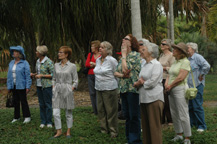 Twenty-eight
members of the Coral Gables Garden Club visited Montgomery Botanical
Center for a lecture on MBC’s collections and history given by Dr.
Patrick Griffith followed by a tour of the property. Twenty-eight
members of the Coral Gables Garden Club visited Montgomery Botanical
Center for a lecture on MBC’s collections and history given by Dr.
Patrick Griffith followed by a tour of the property.
The
Coral Gables Garden Club was established in 1925, and has a deep
history of working to promote gardening and to beautify the Coral
Gables community.
Nell
Montgomery was an early Member and
Director of the Coral Gables Garden Club. Nell hosted a similar
lecture and tour here in early 1936,
which featured a lecture by Col. Robert Montgomery and tour of "the largest
collection of tropical palms in the country."
MBC
thanks
the Coral Gables Garden Club for their support of research,
conservation, and education at Montgomery Botanical Center."I always
enjoy seeing the Coral Gables Garden Club here at MBC. Having such a
steadfast group of supporters in our city helps keep our great
botanical traditions thriving," said Griffith.
January 12, 2010
Montgomery
Fellow, Dr. John Dowe, Publishes Authoritative Book on Palms of
Australia
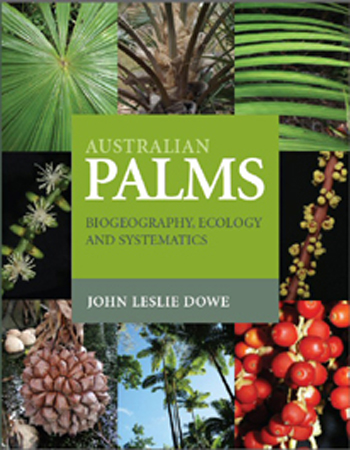 Dr.
John Dowe has completed an important work, Australian
Palms: Biogeography, Ecology and Systematics. The book features
a
detailed treatment of each palm species in Australia, Lord Howe Island,
Norfolk island, and Christmas Island. In all, 60 species are covered,
in 21 genera. The book is available through CSIRO Publishing
(Australia). Montgomery is hosting the supplemental
data for this work on the MBC website. Dr.
John Dowe has completed an important work, Australian
Palms: Biogeography, Ecology and Systematics. The book features
a
detailed treatment of each palm species in Australia, Lord Howe Island,
Norfolk island, and Christmas Island. In all, 60 species are covered,
in 21 genera. The book is available through CSIRO Publishing
(Australia). Montgomery is hosting the supplemental
data for this work on the MBC website.
The
new book represents the results of an extended period of detailed study
of palms. Quoting the preface: “The author has studied and collected
all mainland palm species in their natural habitats, and has studied
those from off-shore territories as cultivated specimens in Australian
botanic gardens such as The Palmetum in Townsville, Flecker Botanic
Gardens in Cairns and Mt Coot-tha Botanic Gardens in Brisbane, and in
Florida at the Fairchild Tropical Botanical Gardens and the Montgomery
Botanical Center. This work is the culmination of over 20 years of
research into Australian palms.”
John’s
work has added many new
discoveries to the palm family. Nineteen new species were described by
John during the course of this work. In addition, John recently
authored a definitive treatment of the genus Livistona.
Dr.
Dowe has been involved in the work of Montgomery Botanical Center for
almost two decades. Beginning with MBC’s collections recovery work
after Hurricane Andrew, John contributed to many of MBC’s living palm
collections. In 2004, the MBC Board of Directors appointed Dr. Dowe as
a Montgomery Botanical Research Fellow. With the generous support of
the Kelly Foundation, John has travelled to MBC every
year since, and contributed a great deal to Montgomery's research,
offered
lectures on his work, and has also co-authored studies with the MBC
team.
January
11, 2010
Cold Temperatures at MBC
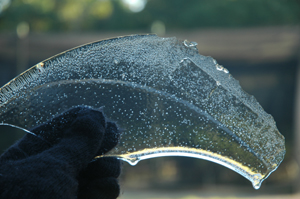 The coldest weather in nine years is being observed at
Montgomery Botanical Center. Over the last week, temperatures have gone
below 45 degrees four times, and the coldest on-site thermometer
reading (36 degrees) was this morning around 5 am. This morning, ice
formed on the lids of the soil bins. The coldest weather in nine years is being observed at
Montgomery Botanical Center. Over the last week, temperatures have gone
below 45 degrees four times, and the coldest on-site thermometer
reading (36 degrees) was this morning around 5 am. This morning, ice
formed on the lids of the soil bins.
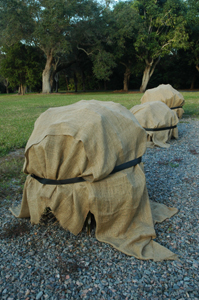
As
with all weather situations, there is some amount of preparation that
can be done. Sensitive palms, like the Hemithrinax in this photo, are
wrapped in burlap when temperatures dip below 50 degrees. In the
nursery, the greenhouse is kept sealed and heated, and the most
sensitive collections are brought in. Before our coldest hour, right
before dawn, the shadehouse irrigation is run.
The
weather recovery process is carefully planned. Treatment of the nursery
collection is currently underway. Recording and tracking the cold
damage is crucial. Thus far, some damage to a few Aiphanes and Zamia is observed, but more damage
may become apparent. The entire nursery collection will be treated with
fungicide as temperatures return to normal.
Over
the years, bouts of cold damage have occurred at The Coconut Grove
Palmetum, The Montgomery Foundation, and MBC. Some plants are lost, and
much hard work must be done, but active development of the living plant
collection continues. The MBC team remains dedicated to these living
treasures, despite cold, heat, rain, or wind.
January 9, 2010
Boy
Scouts Help Restore 1932 Montgomery Greenhouse
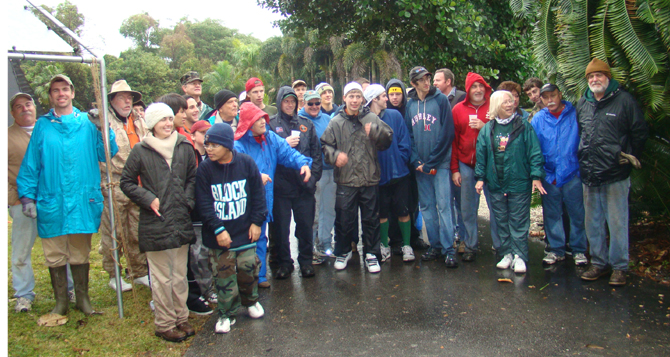
Chris Lancaster from the Boy
Scouts of America Troop 457, Pinecrest, Florida brought a
dedicated, hard working Troop to Montgomery Botanical Center to
complete his Eagle Scout Project.
Chris organized a group of over 75 volunteers to repair shutters and
screens in the greenhouse, and paint the nursery potting area. In
addition, other Scouts removed invasive plants and helped spread mulch
for the plant collections.
The volunteers came out on Saturday in rainy 45°F weather and did a
spectacular job completing the project despite the adverse conditions.
MBC is very thankful to Chris for organizing the project, and to all
the hardworking Scouts and their families for braving the rain and
cold.
Dr. Patrick Griffith states, “These dedicated Scouts represented their
Troop and the BSA very well. The thoughtful, organized project moved us
very far ahead on our work; and it was fun to see everyone having a
great time in the cold, damp conditions. I hope to see many more Eagle
Scout Projects here at Montgomery.”
MBC
News Archive
2005 2006 2007 2008 2009 2010 2011 2012 2013 2014 2015 2016 2017 2018
|



